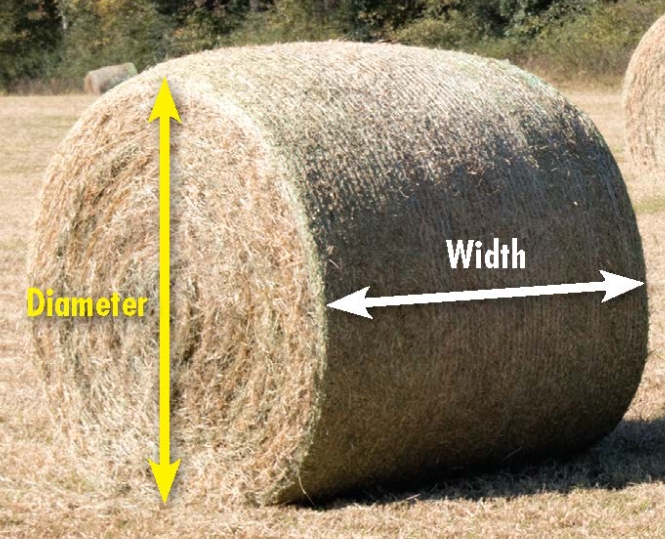Hay bales are an essential component in agriculture, crucial for feeding livestock throughout the year. Whether you’re managing a small hobby farm or a large commercial operation, understanding the types, sizes, and weights of hay bales is key to making informed decisions about purchasing, storing, and handling.
In this comprehensive guide, we’ll explore the various aspects of hay bales to help you navigate your hay needs effectively.
Contents
- 1 How much does a bale of hay weigh and what are its dimensions?
- 2 Types of Hay Bales
- 3 Factors Affecting Hay Bale Weight and Size
- 4 Typical Weight and Size Ranges
- 5 How to Measure and Estimate Hay Bales
- 6 How Are Hay Bales Stored and Transported?
- 7 Why Weight Matters?
- 8 What Is the Difference between Round Bales and Square Bales?
- 9 Applications and Considerations for Buyers
- 10 Conclusion
- 11 FAQs
How much does a bale of hay weigh and what are its dimensions?
A small square bale of hay typically weighs between 40-75 pounds and measures about 14x18x36 inches. A large square bale can weigh 800-1,500 pounds, with dimensions of approximately 48x48x96 inches. Round bales generally weigh between 500-1,200 pounds and have a diameter of 4-6 feet. Understanding these weights and sizes is crucial for efficient storage and transport.
Types of Hay Bales
Hay bales come in various types, each suited to different needs and applications. By familiarizing yourself with the types, you can select the one that best fits your requirements. Let’s explore the characteristics of each type to understand their benefits and uses better.
Small Square Bales
Small square bales are the most common and are typically used by hobbyists and small farmers. These bales are compact and manageable, weighing between 40 and 75 pounds and measuring approximately 14x18x36 inches. Their smaller size makes them ideal for personal handling, stacking, and storage. They are often used for feeding horses and smaller livestock, where precise portioning is essential.
Large Square Bales
Large square bales cater to larger operations due to their size and efficiency. Weighing between 800 and 1,500 pounds, these bales measure around 48x48x96 inches. They offer a more compact storage solution compared to small square bales and are suitable for large-scale feeding operations. Their size means fewer handling and storage efforts for the same amount of feed, making them a popular choice for commercial farms.
Round Bales
Round bales are designed for ease of handling and are often used in extensive pasture management. They weigh between 500 and 1,200 pounds and have a diameter ranging from 4 to 6 feet. Their cylindrical shape allows them to be easily rolled into place and is less prone to moisture damage when stored outdoors. This type of bale is ideal for feeding large herds efficiently.

Factors Affecting Hay Bale Weight and Size
Understanding the factors that influence the weight and size of hay bales is crucial for accurate planning and management. These factors can impact everything from transportation costs to hay quality. Let’s delve into the specifics.
Type of Hay
The type of hay plays a significant role in determining the weight and size of the bales. Hay varieties include grass hay, legume hay, and mixed hay.
- Grass Hay: Typically less dense than legume hay, grass hay includes varieties such as Timothy, Bermuda, and Orchard grass. It’s often used for feeding horses and smaller animals and generally results in lighter bales.
- Legume Hay: This type, such as alfalfa and clover, is richer in protein and nutrients, making it denser and heavier. It’s often used for cattle and other livestock requiring higher nutritional content.
- Mixed Hay: A combination of grasses and legumes, mixed hay provides balanced nutrition and has varying densities depending on the proportions of its components.
The moisture content of hay also affects its weight. Wet hay is heavier but more prone to mold and spoilage, while dry hay is lighter and more stable for long-term storage.
Compression and Density
The compression of hay bales affects their density and weight. Tightly compressed bales are denser and heavier, making them more efficient for storage and transportation. For instance, large square bales are generally more compressed compared to small square bales, leading to a higher weight despite their larger size.
Packaging and Handling
The method of packaging and handling can also influence bale size and weight. Some bales are wrapped in plastic to protect against moisture, which can add extra weight. Additionally, bales can be packed loosely or tightly, affecting their overall density and weight.
Typical Weight and Size Ranges
Knowing the typical weight and size ranges for different types of bales helps in planning for storage and transport. Here’s a breakdown of the common sizes and weights:
Small Square Bales
- Dimensions: 14x18x36 inches
- Weight: 40-75 pounds
Large Square Bales
- Dimensions: 48x48x96 inches
- Weight: 800-1,500 pounds
Round Bales
- Diameter: 4-6 feet
- Weight: 500-1,200 pounds

How to Measure and Estimate Hay Bales
Accurate measurement and estimation of hay bales are essential for managing storage and transport effectively.
Measuring Dimensions
Use a tape measure or measuring wheel to determine the dimensions of the bales. For square bales, measure the length, width, and height. For round bales, measure the diameter and circumference to calculate size.
Estimating Weight
Estimate the weight of hay bales using the formula:
Weight=Density×Volume
where density refers to the weight per unit volume of the hay, and volume is the size of the bale. For round bales, you can approximate weight by measuring the circumference and diameter.
How Are Hay Bales Stored and Transported?
Proper storage and transportation are vital to maintaining hay quality and minimizing loss.
Storage Techniques
Store hay bales in a dry, well-ventilated area to prevent moisture damage. Small square bales are often stored indoors in a barn or shed, while large square and round bales can be stored outdoors with appropriate coverings, such as tarps or plastic wrap, to keep them dry.
Transportation Methods
Transporting hay bales involves using flatbed trucks or trailers. Equipment like bale spears and forks helps in loading and unloading. Proper securing of bales during transport prevents shifting and potential damage.
Why Weight Matters?
Understanding the weight of hay bales is important for several reasons:
Impact on Transport Costs
Heavier bales lead to higher transportation costs due to increased fuel consumption and handling requirements. Efficient planning can help manage these costs effectively.
Nutritional Value and Quality
Heavier, denser bales often indicate higher nutritional content, which can be beneficial for livestock. Evaluating weight in relation to quality helps in selecting the best hay for feeding.

What Is the Difference between Round Bales and Square Bales?
Each type of bale has its advantages and disadvantages, suited to different needs.
Structural Differences
Round bales are cylindrical and easier to roll and handle with machinery, making them suitable for large operations. Square bales are rectangular, allowing for compact stacking and easier individual handling.
Advantages and Disadvantages
Round bales are efficient for large-scale feeding but can be challenging to manage individually. Square bales are labor-intensive to handle but are ideal for smaller farms and more precise feeding.
Applications and Considerations for Buyers
Choosing the right bale type and managing it effectively is crucial for optimal feed use and cost efficiency.
Choosing the Right Bale
Consider factors such as the size of your operation, the type of livestock, and your storage capacity when selecting hay bales. Larger bales are more suitable for large farms, while smaller bales are better for smaller operations.
Storage and Handling Tips
Proper storage methods include keeping bales dry and using appropriate equipment for handling. This ensures the longevity and quality of the hay.
Conclusion
A thorough understanding of hay bales, including their types, sizes, weights, and handling requirements, equips you to make informed decisions for your livestock needs. By considering these factors, you can optimize your hay usage and manage costs effectively.
FAQs
Store hay bales in a dry, well-ventilated area. For outdoor storage, use tarps or plastic wrap to protect bales from moisture and pests.
Round bales are easier to handle with machinery and are less prone to moisture damage, making them suitable for large farms. Square bales, however, are more manageable for smaller operations and allow for compact stacking

